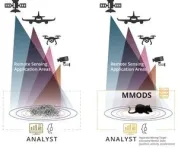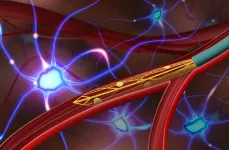(Press-News.org) The ECOG-ACRIN Cancer Research Group (ECOG-ACRIN) has enrolled the first patient in a new treatment trial to evaluate the effectiveness of adding nilotinib to standard paclitaxel chemotherapy. The trial (EAY191-E4) is for the treatment of adults with cancers that are getting worse after being treated with taxane-based chemotherapy. It is a new addition to the recently launched ComboMATCH precision medicine initiative, which uses tumor biology as a guiding point for testing new combinations of cancer drugs.
James M. Ford, MD, the ECOG-ACRIN Chair for ComboMATCH and Professor of Medicine (Oncology) and Genetics at Stanford University, states that “the pre-clinical experimental data supporting the use of nilotinib in overcoming taxane resistance in all solid tumor types is extremely compelling. I am confident the ComboMATCH E4 treatment trial will accrue quite rapidly given the excitement surrounding this approach and the broad eligibility for cancer patients.”
Chemotherapy treatments are part of the standard-of-care options for adults with advanced cancers, either alone or in combination with other treatments. Taxane-based chemotherapy drugs, which contain chemicals that are toxic to living cells, have decades of use to prevent cancer cells from dividing. Cancer cell division leads to increasing tumor size and malignancy. However, when taxanes are used alone in patients with advanced disease, especially those who had prior taxane therapy, tumors will continue to grow and spread in about 90% of patients.
One taxane used to treat cancer is paclitaxel. Sometimes proteins in tumors block this drug from working. In the EAY191-E4 trial, researchers want to see if another drug, nilotinib, helps paclitaxel work better. Nilotinib is part of a class of medications called kinase inhibitors. It is given in pill form and works by binding to and inhibiting the action of a protein that signals cancer cells to multiply—essentially blocking the protein from blocking the paclitaxel. This helps slow or stop cancer cells. Nilotinib is FDA-approved to treat adults with certain types of chronic myeloid leukemia (CML).
Pre-clinical studies using human tumor cell lines recently showed that nilotinib and paclitaxel may be stronger and more effective together at killing cancer cells than either drug alone. A phase 1 clinical trial (NCT02379416) has tested the safety of the combination in a small group of patients with advanced cancers. The trial has demonstrated efficacy, including tumor reduction in patients who did not benefit from prior taxane-based therapy.
Surprisingly, both this trial and the pre-clinical data found less nerve damage in hands and feet (peripheral neuropathy) from the combination compared to paclitaxel alone. Peripheral neuropathy is a common and painful side effect of paclitaxel.
Based on these discoveries, researchers have opened the EAY191-E4 trial to evaluate the nilotinib-paclitaxel combination. Further, as they collect information on the side effects of the treatment, they hope to determine whether nilotinib may help make paclitaxel less toxic and more tolerable for patients. If this trial is successful, the combination would move on to a larger randomized phase 3 trial for confirmation outside of ComboMATCH.
To be eligible for EAY191-E4, patients must have solid tumor cancers (not a liquid/blood cancer such as leukemia or lymphoma) that are progressing after being treated with taxane therapies. They must not have a mutation in the c-KIT or PDGFRA tumor genes. Patients must first enroll in the ComboMATCH registration trial (EAY191) to determine their eligibility for this trial. More information is available in this Study Summary for Patients.
The trial seeks to enroll 40 patients. All participants will receive nilotinib and paclitaxel together in cycles that will repeat every 28 days. Patients may stay on treatment so long as the tumors shrink or remain stable, and they are able to tolerate the side effects of treatment. Patients will have imaging (CT scans or MRI) before, during, and after treatment to measure tumor size and thus monitor which tumors respond to--or resist--the combination treatment.
Another goal of the trial is to gather information for future research. To that end, patients will undergo a tumor biopsy and submit blood samples before starting treatment. Blood samples are being collected to look for the presence of circulating tumor DNA.
Learn more about EAY191-E4 at ecog-acrin.org.
About ComboMATCH
EAY191-E4 is part of ComboMATCH (Molecular Analysis for Combination Therapy Choice), a large precision medicine initiative with a coordinated set of clinical trials evaluating novel drug combinations. The ComboMATCH patient registration trial is being led by the ECOG-ACRIN Cancer Research Group (ECOG-ACRIN) and the National Cancer Institute, part of the National Institutes of Health. Treatment trials are being conducted by the Alliance for Clinical Trials in Oncology, Children’s Oncology Group, ECOG-ACRIN, NRG Oncology, and SWOG Cancer Research Network. Learn more at www.ecog-acrin.org/combomatch.
About ECOG-ACRIN
The ECOG-ACRIN Cancer Research Group is a membership-based scientific organization that designs and conducts cancer research involving adults who have or are at risk of developing cancer. The Group comprises nearly 1300 member institutions and 15,000 research professionals in the United States and around the world. Visit ecog-acrin.org, follow us on Twitter @eaonc, Facebook, and LinkedIn, or call 215.789.3631.
###
END
In Africa, climate change impacts are experienced as extreme events like drought and floods. Through the Famine Early Warning Systems Network (which leverages expertise from USG science agencies, universities, and the private sector) and the IGAD Climate Prediction and Applications Center, it has been possible to predict and monitor these climatic events, providing early warning of their impacts on agriculture to support humanitarian and resilience programming in the most food insecure countries of the world.
Science is beginning to catch up with and even ...
ALBUQUERQUE, N.M. — Remember what it’s like to twirl a sparkler on a summer night? Hold it still and the fire crackles and sparks but twirl it around and the light blurs into a line tracing each whirl and jag you make.
A new patented software system developed at Sandia National Laboratories can find the curves of motion in streaming video and images from satellites, drones and far-range security cameras and turn them into signals to find and track moving objects as small as one pixel. The developers say this system can enhance the performance of any remote sensing application.
“Being able to track each pixel from a distance matters, ...
For the first time, Oxford chemists have generated fluorochemicals – critical for many industries – without the use of hazardous hydrogen fluoride gas.
The innovative method was inspired by the biomineralization process that forms our teeth and bones.
The results are published today in the leading journal Science.
A team of chemists have developed an entirely new method for generating critically important fluorochemicals that bypasses the hazardous product hydrogen fluoride (HF) gas. ...
Inducing labor at 39 weeks of pregnancy has the greatest benefit in risk reduction for women from more socioeconomically deprived areas, according to a new study published July 13th in the open access journal PLOS Medicine by Ipek Gurol-Urganci of the London School of Hygiene & Tropical Medicine, UK, and colleagues. The findings suggest that increased uptake of induction of labor at 39 weeks may help reduce inequities in adverse perinatal outcomes.
Adverse perinatal outcomes— which include stillbirths, neonatal ...
A new ultra-small and ultra-flexible electronic neural implant, delivered via blood vessels, can record single-neuron activity deep within the brains of rats, according to new study. “This technology could enable long-term, minimally invasive bioelectronic interfaces with deep-brain regions, writes Brian Timko in a related Perspective. Brain-machine interfaces (BMIs) enable direct electrical communication between the brain and external electronic systems. They allow brain activity to directly ...
Sediments recovered from the base of the Camp Century ice core show that northwestern Greenland was ice-free during a period of history known to have exhibited some of the lowest global ice volumes -- the Marine Isotope Stage (MIS) 11 interglacial period. The absence of ice at that location means that the Greenland Ice Sheet must have contributed more 1.4 meters of sea-level equivalent to global sea level during the interglacial – a period in which average global air temperature was similar to what we’ll soon experience, given human-caused climate warming. The climate conditions of past interglacials – periods during Earth’s climatic history ...
Analysis of Global Positioning System (GPS) time-series data from nearly 100 large earthquakes worldwide has provided evidence for the existence of a precursory phase of fault slip occurring two hours before seismic rupture. “If it can be confirmed that earthquake nucleation often involves an hours-long precursory phase, and the means can be developed to reliably measure it, a precursor warning could be issued,” writes Roland Bürgmann in a related Perspective. The ability to predict large earthquakes has been a longstanding yet elusive goal. Short-term ...
Combining data from full-body x-ray images and associated genomic data from more than 30,000 UK Biobank participants, researchers have helped illuminate the genetic basis of human skeletal proportions. The findings not only provide new insights into the evolution of the human skeletal form and its role in musculoskeletal disease, but they also demonstrate the utility of using population-scale imaging data from biobanks to understand both disease-related and normal physical variation among humans. Of all primates, humans are the only ones to have evolved to be normally bipedal, an adaptation that may have facilitated the use of tools and accelerated cognitive development. ...
Using artificial intelligence to analyze tens of thousands of X-ray images and genetic sequences, researchers from The University of Texas at Austin and New York Genome Center have been able to pinpoint the genes that shape our skeletons, from the width of our shoulders to the length of our legs.
The research, published as the cover article in Science, pulls back a curtain on our evolutionary past and opens a window into a future where doctors can better predict patients’ risks of developing conditions such as back pain or arthritis in later life.
“Our research is a powerful demonstration of the impact of AI in medicine, particularly when it comes to analyzing ...
Immune systems develop specific genes to combat common bacteria such as those found in food, new research shows.
Previous theories have suggested that antimicrobial peptides – a kind of natural antibiotics – have a general role in killing a range of bacteria.
However, the new study, published in Science, examined how the immune systems of fruit flies are shaped by the bacteria in their food and environment.
The researchers, from the Swiss Federal Institute of Technology and the University of Exeter, found two peptides that each control a single bacterial species commonly encountered by the flies.
“We know that an animal’s food and environment ...







